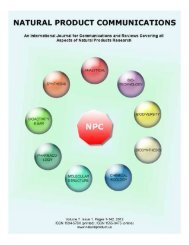This Issue is Dedicated to the Memory of Professor Ivano Morelli
This Issue is Dedicated to the Memory of Professor Ivano Morelli
This Issue is Dedicated to the Memory of Professor Ivano Morelli
Create successful ePaper yourself
Turn your PDF publications into a flip-book with our unique Google optimized e-Paper software.
Naphthalene triglycoside from Kenyan Aloe species Natural Product Communications Vol. 1 (12) 2006 1087<br />
Table 1: NMR data <strong>of</strong> compounds 1 and 2 in CD 3 OD at 400 MHz ( 1 H) and 100 MHz ( 13 C). a, b<br />
kenyaloside (1) Compound 2<br />
C/H position δ Η (J, Hz) δ C Selected 1 H- 1 H NOEs δ Η (J, Hz) δ C Selected 1 H- 1 H NOEs<br />
1 152.69 152.56<br />
2 123.06 122.96<br />
3 134.10 134.12<br />
4 7.48 s 119.77 7.52; 4.73, 4.94; 4.31 7.47 s 119.73 7.51; 4.71, 4.93<br />
4a 137.03 137.05<br />
5 7.52 d (8.0) 122.94 7.48; 7.45 7.51 dd (8.3, 1.1) 122.83 7.47; 7.45<br />
6 7.45 dd (7.6, 8.0) 127.97 7.52; 7.33 7.45 dd (7.8, 8.3) 127.97 7.51; 7.32<br />
7 7.33 d (7.6) 109.92 7.45; 5.77 7.32 dd (7.8, 1.1) 109.91 7.45; 5.75<br />
8 153.68 153.66<br />
8a 114.74 114.71<br />
COCH 3 206.70 206.59<br />
COCH 3 1.95 s 30.84 1.89 31.62<br />
CH 2 O 4.73 d (12.4)<br />
68.80 4.31, 7.48 4.71 d (12.4)<br />
68.78 4.27, 7.47<br />
4.94 d (12.4)<br />
4.93 d (12.4)<br />
1’ 4.39 d (8.0) 102.46<br />
2’ 3.23 dd (8.0, 8.8) 73.67<br />
3’ 3.33 m e 76.85 c<br />
4’ 3.33 m e 70.67 d<br />
5’ 3.33 m e 77.10 c<br />
6’ 3.67 dd (5.2, 12.0) 61.64<br />
3.89 dd (1.6, 12.0)<br />
1” 5.77 d (1.8) 100.85 7.33 5.75 d (1.9) 100.83 7.32<br />
2” 4.21 dd (1.8, 3.4) 70.56 4.20 dd (1.9, 3.5) 70.66<br />
3” 3.85 dd (3.4, 9.2) 71.58 3.84 dd (3.5, 9.3) 71.55<br />
4” 3.57 t (9.2) 72.42 3.56 t (9.3) 72.40<br />
5” 3.71 m 70.72 d 3.70 m 70.71<br />
CH 3 (5”) 1.31 d (6.4) 17.02 1.29 d (6.1) 17.02<br />
1”’ 4.31 d (7.2) 103.09 4.73, 4.94, 7.48 4.27 d (7.3) 103.30 4.71, 4.93<br />
2”’ 3.29 dd (7.2, 8.8) 73.82 3.23 dd (7.3, 9.0) 73.97<br />
3”’ 3.50 t (8.8) 75.11 3.35 t (9.0) 76.85<br />
4”’ 3.71 m 77.65 3.50 m 70.23<br />
5”’ 3.33 m e<br />
63.58 3.19 dd (10.1, 11.5) 65.94<br />
4.06 dd (5.2, 12.0)<br />
3.88 dd (5.4, 11.5)<br />
a<br />
Spectra recorded at 40°C; b all assignments were based on extensive 1D and 2D NMR measurements (COSY, TOCSY, NOESY, APT, HMQC and HMBC);<br />
c,d signals with <strong>the</strong> same superscript are interchangeable; e covered by <strong>the</strong> CH 3 OH signal.<br />
heating at 150°C. Silica gel 60, 63-200 μm and 40-63<br />
μm (Merck) was used for column and flash<br />
chroma<strong>to</strong>graphy, respectively.<br />
Plant material: The commercial exudate <strong>of</strong> Kenyan<br />
Aloe species used in th<strong>is</strong> investigation was purchased<br />
from Sessa Carlo spa (Ses<strong>to</strong> S. Giovanni, Italy). A<br />
voucher specimen <strong>is</strong> kept at <strong>the</strong> Dipartimen<strong>to</strong> di<br />
Chimica Organica e Industriale, Università di Milano<br />
Extraction and <strong>is</strong>olation: The dried exudate <strong>of</strong><br />
Kenyan Aloe species (250 g) was finely powdered<br />
and extracted with water (750 mL) with vigorous<br />
mechanical stirring for 24 h at room temperature.<br />
After filtration <strong>of</strong> <strong>the</strong> insoluble material, <strong>the</strong> aqueous<br />
solution was partitioned with ethyl acetate (2 x 1 L)<br />
and lyophilized <strong>to</strong> give a brown residue (120 g). Of<br />
th<strong>is</strong> residue, 40 g was adsorbed on<strong>to</strong> sea sand and<br />
fractioned by flash chroma<strong>to</strong>graphy (silica gel, 1.5<br />
Kg) eluting with EtOAc containing increasing<br />
amounts <strong>of</strong> MeOH. Separation was moni<strong>to</strong>red by<br />
TLC (eluent A) and fractions containing 1 (Rf 0.38)<br />
were combined, concentrated (3.5 g) and fur<strong>the</strong>r<br />
purified by flash chroma<strong>to</strong>graphy (silica gel, 500 g)<br />
eluting with EtOAc-EtOH-H 2 O, 100:20:10. Fractions<br />
were combined on <strong>the</strong> bas<strong>is</strong> <strong>of</strong> TLC analys<strong>is</strong> (eluent<br />
A) and evaporated <strong>to</strong> dryness. The residue (ca. 400<br />
mg) was chroma<strong>to</strong>graphed over a Sephadex LH-20<br />
column eluted with MeOH-H 2 O (1:1) <strong>to</strong> give<br />
kenyaloside (1) (200 mg, 0.08% overall yield) as an<br />
amorphous powder, pure by TLC (eluent A).<br />
Kenyaloside [1-(β-D-glucopyranosyloxy)-8-(α-Lrhamnopyranosyloxy)-3-(β-D-xylopyranosyloxymethyl)naphthalene<br />
(1)]<br />
[α] D : - 84.4º (c 0.25, MeOH).<br />
Rf : 0.38 (AcOEt-EtOH-H 2 O, 100:20:13).<br />
IR (KBr): 1695, 1652,1615 cm -1 .<br />
UV/V<strong>is</strong> λ max (MeOH) nm (log ε): 226 (4.72), 260<br />
(4.36), 290sh (4.30), 338 (3.94) [for dimethyl<br />
dianellidin (3) [6]: 223 (4.68), 253 (4.04), 331<br />
(3.61)].<br />
1 H NMR (400 MHz, CD 3 OD): Table 1.<br />
13 C NMR (100 MHz, CD 3 OD): Table 1.<br />
ESI-HRMS: m/z [M + Na + ] calcd for C 30 H 40 NaO 17<br />
695.21577, found 695.21326.<br />
ESI MS: m/z 695 [M + Na + ], 549 [M-146+Na + ].<br />
Enzymatic hydrolyses: β-Glucosidase (almond<br />
emulsin, Sigma, 30 mg) was added <strong>to</strong> a solution <strong>of</strong>







